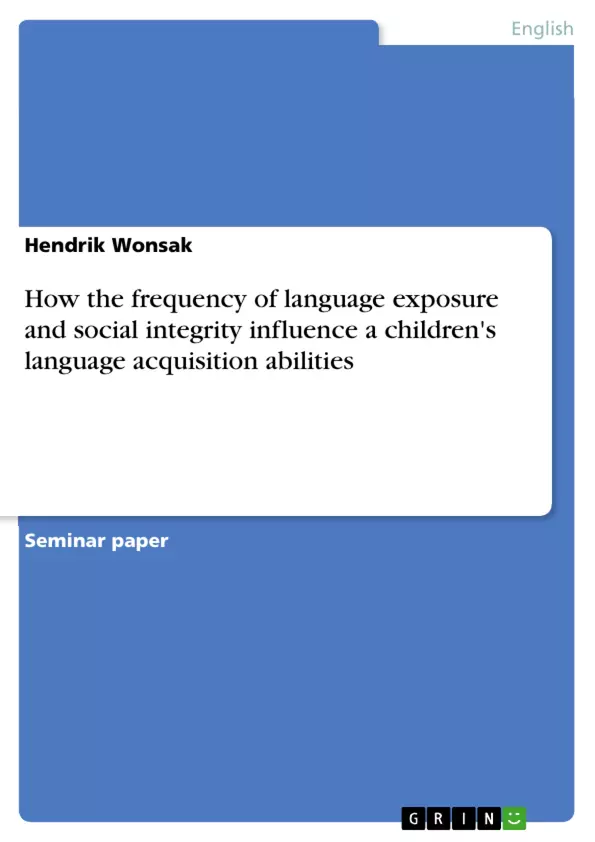The purpose of this term paper is to analyze the influences that the frequencies of language exposures and usage have on learners of a language.
The analysis draws upon several theories, mentioned in Nick Ellis's “Frequency-based accounts of second language acquisition” and a “Longitudinal Study of Lexical Development in Children Learning Vietnamese and English” by Giang Pham and Kathryn Kohnert, who tested the language acquisition abilities of Vietnamese-American children that learned Vietnamese as a first language and English as a second language.
Inhaltsverzeichnis (Table of Contents)
- 1. Introduction
- 2. Theoretical part
- 2.1. English and Vietnamese
- 2.2. Social integration and identity
- 2.3. Word processing
- 2.4. Frequency of exposure
- 3. Hypotheses
- 4. Practical part
- 4.1. The participants
- 4.2. Study design
- 4.3. Results
- 5. Discussion
- 6. Conclusion
- 7. References
- 8. List of tables
- 9. List of figures
Zielsetzung und Themenschwerpunkte (Objectives and Key Themes)
This term paper aims to analyze the influence of language exposure and usage frequency on second language learners. The analysis draws upon theories from Nick C. Ellis's "Frequency-based accounts of second language acquisition" and a longitudinal study of Vietnamese-American children learning English as a second language.
- The impact of language exposure frequency on second language acquisition
- The role of social integration and identity in language learning
- The relationship between word processing and language acquisition
- The influence of different language systems on second language learning
- The application of psycholinguistic theories to real-world language learning scenarios
Zusammenfassung der Kapitel (Chapter Summaries)
- Introduction: Introduces the topic of language acquisition and the importance of frequency of exposure and usage. It establishes the context for the term paper, highlighting the relevance of the research in modern society.
- Theoretical Part: Explores the theoretical framework behind the study, examining the relationship between English and Vietnamese, the role of social integration and identity, and the process of word processing in language acquisition.
- English and Vietnamese: Compares the two language systems, highlighting their differences and similarities. This section explores the impact of these differences on language acquisition.
- Social Integration and Identity: Discusses the role of social participation and identity in language learning, emphasizing the influence of social groups on language acquisition.
- Word Processing: Examines the process of word recognition and storage in memory, highlighting the importance of rote rehearsal and deeper elaboration in language learning.
- Frequency of Exposure: Delves into the significance of frequency of exposure and usage in language acquisition. This section explores the role of repetition and active engagement in language learning.
- Hypotheses: Outlines the specific hypotheses that will be tested in the practical part of the study.
- Practical Part: Describes the participants, study design, and results of the longitudinal study on Vietnamese-American children learning English as a second language.
- The Participants: Provides details about the participants in the study, including their age, language background, and socioeconomic status.
- Study Design: Explains the methodology used in the study, outlining the data collection techniques and analysis methods.
- Results: Presents the key findings of the study, highlighting the relationship between language exposure, usage frequency, and the children's language acquisition abilities.
- Discussion: Interprets the results of the study, drawing connections between the findings and the theoretical framework presented earlier. This section discusses the implications of the study for language acquisition research and practice.
Schlüsselwörter (Keywords)
The core concepts of this term paper revolve around language acquisition, frequency of exposure, social integration, word processing, and the influence of language systems on second language learning. The study focuses on the practical application of psycholinguistic theories to real-world scenarios, using the example of Vietnamese-American children learning English as a second language.
- Quote paper
- Hendrik Wonsak (Author), 2015, How the frequency of language exposure and social integrity influence a children's language acquisition abilities, Munich, GRIN Verlag, https://www.grin.com/document/337442



